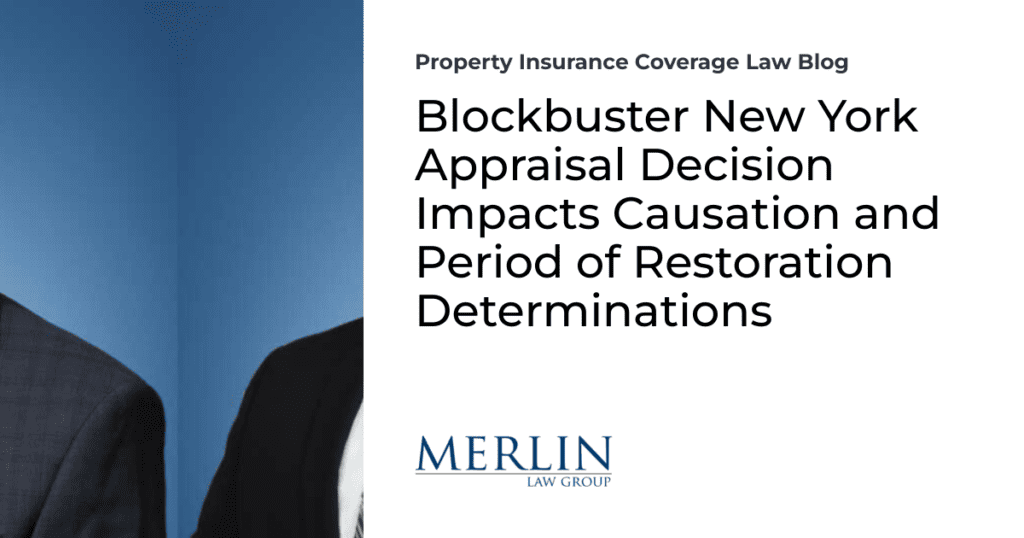Blockbuster New York Appraisal Decision Impacts Causation and Period of Restoration Determinations

Isn’t it great when people work collaboratively on a noble cause and grand success happens?
Merlin Law Group attorneys Drew Houghton from Oklahoma and Dan Ballard from Redbank, New Jersey, worked with policyholder attorney Jason Liss from Michigan to obtain a significant ruling yesterday in the Southern District of New York.1
In summary, the case decided that:
Appraisal can determine causation of a loss in New York.
The insurer’s actions and delays can extend the period of restoration.
The insurance company argued that causation and other issues were “coverage issues” reserved for the court. The judge saw through this increasingly common but flawed argument by attorneys for insurance companies, ruling:
Plaintiff argues that the alleged ‘coverage issues’ identified by Defendant are in reality nothing more than factual disputes pertaining to causation and the amount of loss. I agree. First, with regard to the issue of ‘whether direct physical loss or damage occurred during the relevant Policy period,’ no genuine dispute exists. Defendant conceded that physical loss or damage occurred during the relevant Policy period by assuming partial coverage for the loss. While Defendant correctly notes that assumption of partial coverage does not automatically eliminate the possibility of additional coverage issues, …. acceptance of coverage does eliminate the possibility that this particular coverage question remains an issue. The dispute which damage was caused by the June 10 windstorm or by the July 13 windstorm goes to causation.
Turning to the remaining five coverage issues claimed by Defendant, none of them requires the Court to interpret the meaning of the terms of the insurance contract or opine on the scope of coverage. Plaintiff does not dispute that the Policy offers no coverage for damage from ‘prior loss,’ ‘wear and tear,’ or ‘cosmetic damage.’ Similarly, Plaintiff does not dispute that the age of the roofs would affect the amount recoverable and has provided undisputed documentary evidence that the roofs are less than 20 years old. There are no genuine legal disputes regarding the terms of the Policy. All that remains are factual questions relating to damages, and damage issues are appropriate for appraisal. See Zarour v. Pac. lndem. Co., 113 F. Supp. 3d 711, 715-16 (S.D.N.Y. 2015) (‘[A]pportioning damage causation’ is ‘essentially a factual question … to be resolved by making factual judgments about events in the world, not legal analyses of the meaning of the insurance contract. … Therefore, the issue of damage causation is properly subject to appraisal.’) (citing Amerex Grp., Inc. v. Lexington Ins. Co., 678 F.3d 193,206 (2d Cir.2012)).
Turning to the insurer’s actions or inactions impacting the period of restoration, the court again ruled for the policyholder:
I agree with Plaintiff. An insurer’s delay in paying amounts to repair an insured property may affect the theoretical period needed to repair such property. See Streamline Capital, L.L.C. v. Hartford Cas. Ins. Co., No. 02 Civ. 8123, 2003 WL 22004888, (S.D.N.Y. Aug. 25, 2003) (‘Several cases from other jurisdictions support the view that a delay in payment may have a direct effect on the timing of an insured’s resumption of business.’). SR Int’l Bus. Ins. Co. v. World Trade Ctr. Properties, LLC, 2005 WL 827074 (S.D.N.Y. Feb. 15, 2005), cited by defendant, holds only that the time to make repairs is a theoretical, not an actual, calculation, but does not dispute the general rule that an insurer’s delay can add to the theoretical time-period.
The language of the policy is clear: the Period of Liability ‘end[s] when with due diligence and dispatch the building and equipment could be repaired or replaced[.]’ The key inquiry for the theoretical calculation is when Plaintiff could have repaired or replaced the relevant property. It follows that any facts affecting the insured’s ability to repair the property with due diligence and dispatch are proper considerations for the theoretical calculation. See 2005 WL 827074 (citing United Land Investors, Inc. v. Northern Ins. Co. of Am., 476 So.2d 432 (La.Ct.App. 1985) (extending restoration period to account for delays caused by insurers); Eureka-Security Fire & Marine Ins. Co. v. Simon, 1 Ariz.App. 274, 401 P.2d 759 (Ariz.Ct.App.1965) (extending restoration period for delays caused by insurers and landlord.) An insurer’s delay in payment may affect the calculation when an insured could have repaired or replaced the premises. Whether Defendant’s delay in payment actually impacted Plaintiff’s ability to repair or replace the Property is a disputed issue of fact.
The logic of both findings is sound. Appraisals need to determine the amount of damage and consider various facts to do so. Those facts concerning damage are what property insurance adjusters do all the time without thinking that these are coverage issues. Adjusters always debate how much wear and tear was present and the various facts of delay that occurred regarding the period of restoration to determine the amount of the loss. Appraisal is not just a debate about the factual price of a nail or piece of lumber.
A great result for policyholders everywhere.
Thought For The Day
Unity is strength… when there is teamwork and collaboration, wonderful things can be achieved.
—Mattie Stepanek
1 Laxminarayan Lodging v. First Specialty Ins. Corp., No. 1:21-cv-07506 (S.D.N.Y. May 11, 2023).



